Kimchi Soondooboo Jeongol
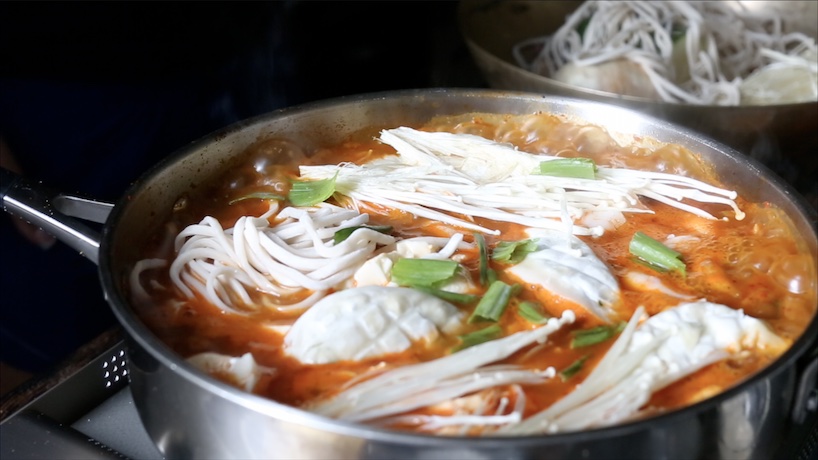
Whenever you go to a Korean restaurant, there will be a section of the menu that’s devoted to hot pots or “jeongols.” They are cooked at the table and are designed to be shared by the table. I always loved getting budae jeongol (a large budae chigae) with my family or friends, so that I could have a bowl of stew with my rice and whatever “entree” I ordered. While most jeongols are “meat-centric,” I wanted to make something that was tofu forward, because I love silken tofu so much. I also had a jar of leftover kimchi that was just aching to be used, so I thought I’d revisit my epic kimchi-soondooboo mashup and make it jeongol style.
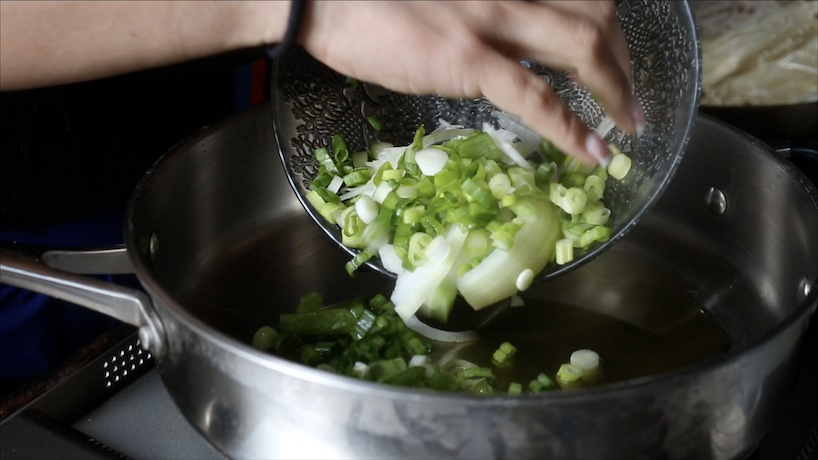
Think of this recipe as a mix between soondooboo and kimchi and budae chigae. You start out by infusing the oils (I used both olive oil and sesame oil) with some aromatics: onions, scallions, garlic, and gochugaru. Remember, watch the gochugaru so it doesn’t burn. If the gochugaru starts to turn brown, you will have a brown and bitter stew.
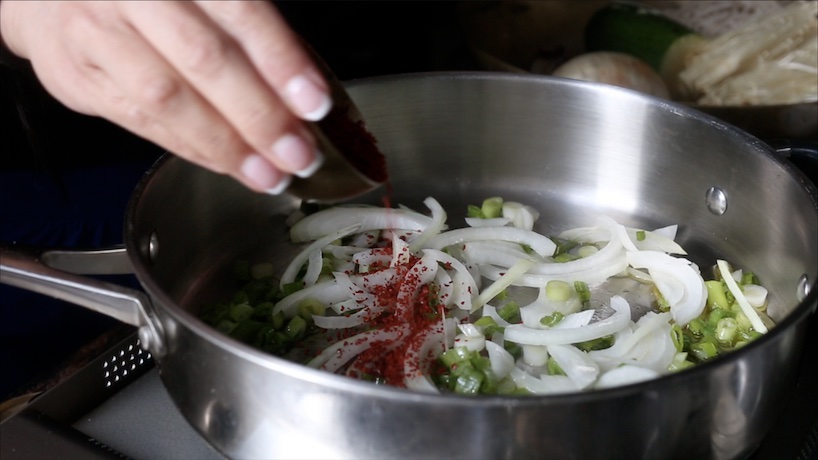
I add a healthy amount of kimchi. Now, for non-vegan kimchi, I always had to wait until the kimchi was super stinky. The thing is, vegan kimchi doesn’t really get that stinky (thanks to the elimination of fish sauce). So, in lieu of using smell as my guide for when kimchi is good for stewing, I just let the kimchi sit in my fridge for at least a week before adding it to my soup.
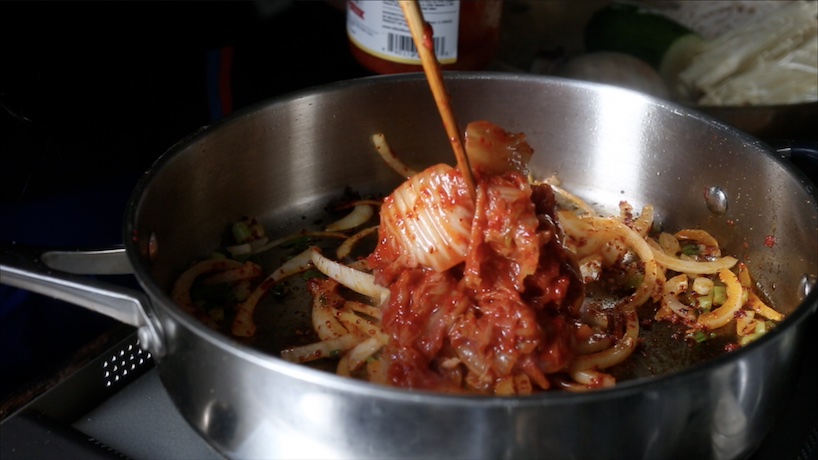
The other thing I like to add to my kimchi chigae (or stew) is gochujang. Some people don’t add any gochujang to their kimchi chigae, but I find that it adds a lovely deep smokiness and a hint of sweetness to my kimchi chigae. The thing with any stew, of course, is about developing layers of flavor. That’s why we start out with the aromatics, add the kimchi, and then hit it all with some gochujang–fermented soybean chili paste.
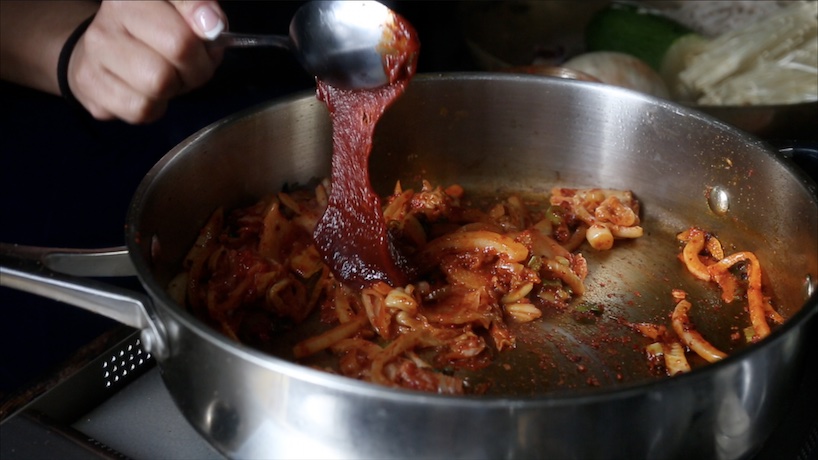
To ensure the broth is velvety and lovely, I like to use a good vegetable broth. If I don’t have any of my own on hand, I’ll just store bought. If you don’t have broth, you can, of course, use water. But, in my opinion, using a vegetable broth (one that you like) makes a humongous difference in flavor and consistency.
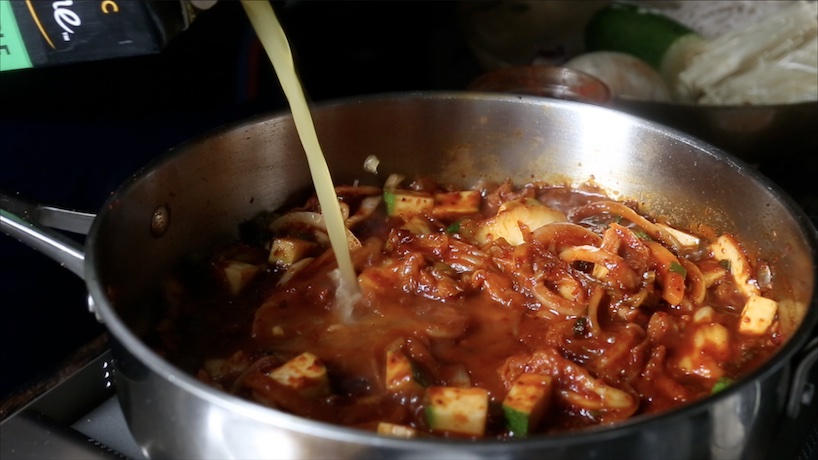
Finally, add the silken tofu. I always get asked “what are those white jiggly things?” when I make soondoboo chigae. “Soondooboo” means silken tofu (“dooboo” literally means tofu). Silken tofu tastes a lot like plain yogurt, only a little bit firmer and no real sourness. It’s a very bland flavor, but has the ability to take on the flavors around it. A lot of folks use silken tofu for their smoothies or as an egg replacer, but I’ve always just enjoyed the taste and texture of silken tofu, without using it as a stand-in for something else.
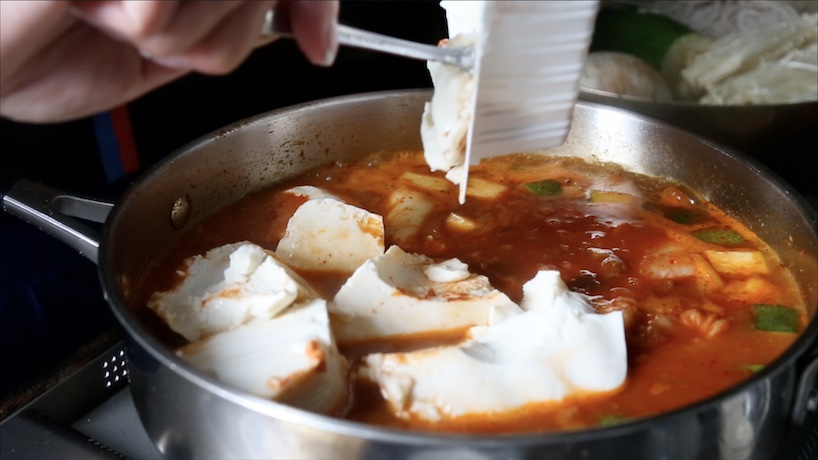
After adding the silken tofu, you get to have some fun! I took inventory of my freezer and fridge and picked a few things I wanted to add–ricecakes (the kind you use for tteokbokki), some dumplings, and some fresh noodles (the ones I didn’t use when I accidentally made tofu fettuccini). I grabbed a handful of fresh enoki mushrooms that I only just started falling in love with, before heading back to my pot. I also had a bag of frozen corn that I almost dumped into the stew, but decided I didn’t want to go overboard (literally–didn’t want to have my stew spilling over the edge!).
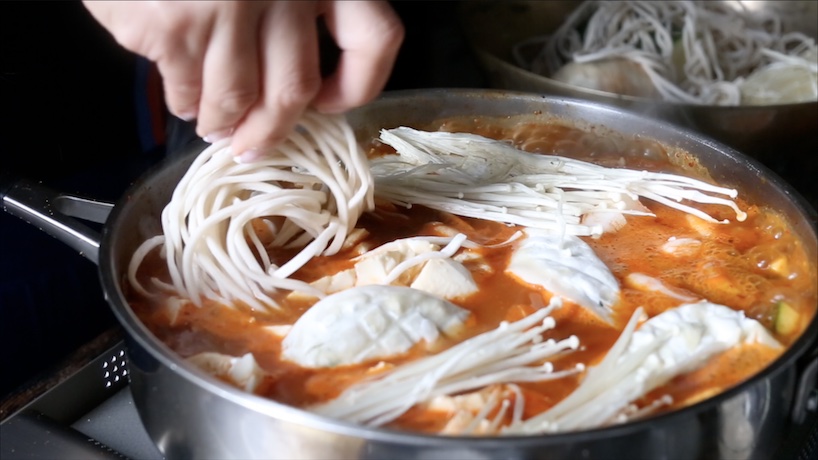
And then you just bring everything to a boil and let it do it’s thing for a few minutes, until the noodles are cooked, the ricecakes are soft, and the dumplings are not longer frozen.
Quick Tips:
- Keep an eye on your gochugaru, to make sure it doesn’t burn. Your stew should be a bright orange color–not brown. If it’s brown, that means you burned the gochugaru in the beginning, which will make it bitter.
- Make sure to reserve some kimchi juice to add to the stew for extra kimchi flavor.
- Use vegetable broth (homemade or store bought) in favor of water, for a richer and more dynamic flavor.
- Use both gochujang and soy sauce to build multiple layers of flavor.
- Do not overcook the stew–once the noodles and rice cakes are fully cooked, start eating. Otherwise, the kichi will become soggy and not fun. 🙁
- Make this recipe gluten free by using gluten free soy sauce and gluten free gochujang.
Video
Recipe Card
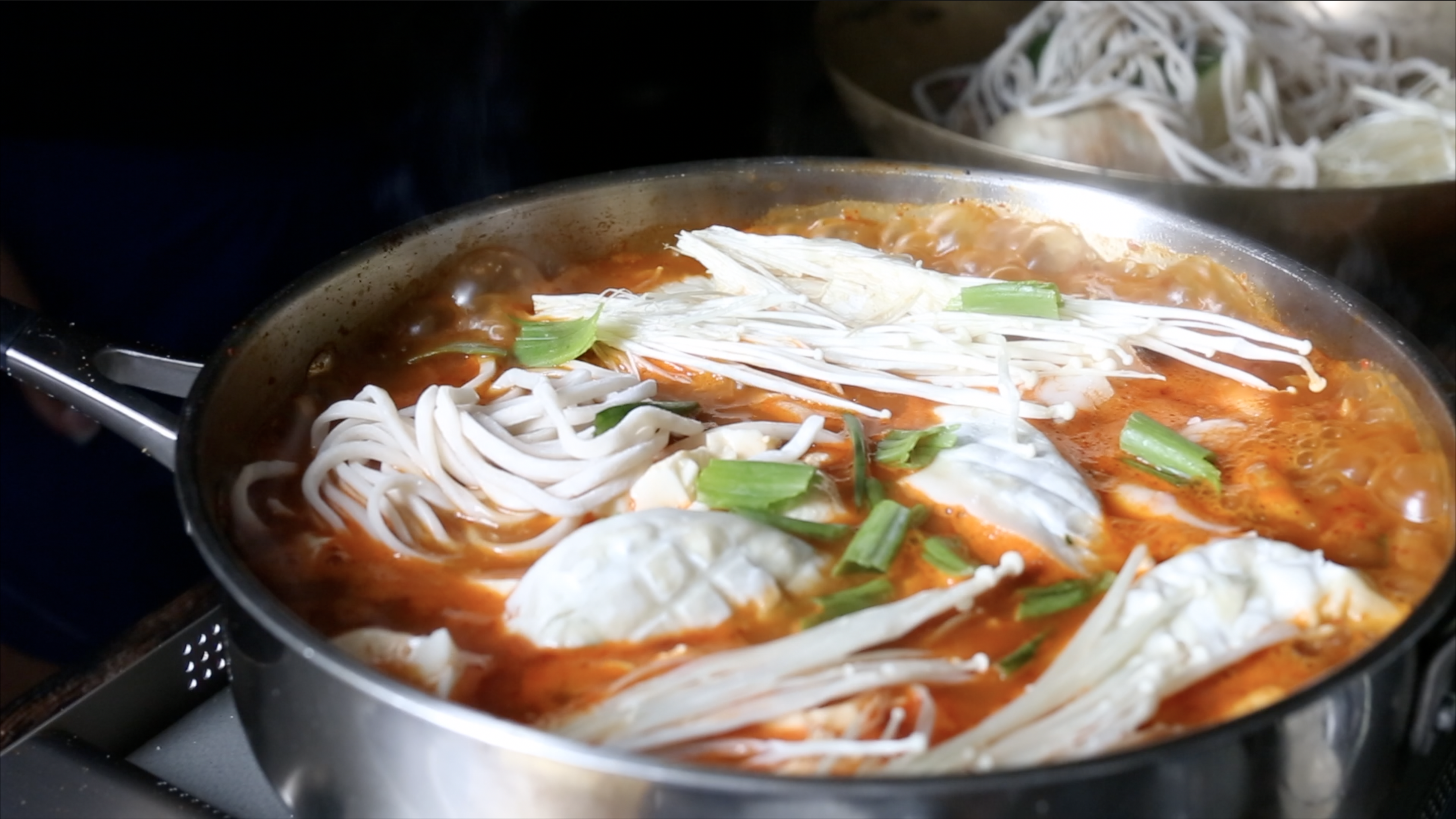
Kimchi Soondooboo Jeongol
Ingredients
- 1 tbsp extra virgin olive oil
- 1/2 tsp sesame oil
- 1/4 cup julienned onion
- 4 scallions, chopped
- 1 tbsp minced garlic
- 2 tbsp gochugaru use less if too spicy
- 1 cup vegan kimchi
- 1 1/2 tbsp gochujang
- 2 tbsp soy sauce
- 1/2 cup chopped zucchini
- 3 cups vegetable broth
- 1 tbsp kimchi juice liquid in kimchi jar
- 1 container silken tofu
- 1/2 cup ricecakes
- 4 to 5 frozen dumplings
- 4 ounces fresh noodles can sub in ramen noodles
- 3 handfuls enoki mushrooms
- 1 tbsp chopped scallion greens
Instructions
- Add 1 tbsp of olive oil and sesame oil in a large pan over medium high heat.
- Add onions, scallions, and garlic and sautee until they become translucent, about 3 minutes. Add gochugaru and cook for 30 seconds.
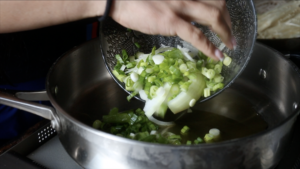
- Add kimchi, zucchini, and gochujang, and stir until vegetables are evenly coated with sauce. Add soy sauce and vegetable broth, together with kimchi juice.
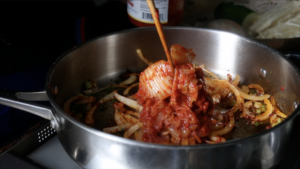
- Spoon the silken tofu into the broth in chunks.
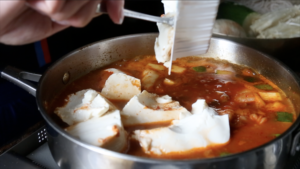
- Add the ricecakes, dumplings, noodles, and enoki mushrooms. Bring the soup up to a boil and continue cooking at a gentle boil until the ricecakes are soft and the noodles are cooked.
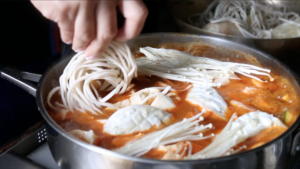
- Garnish with scallion greens before serving.
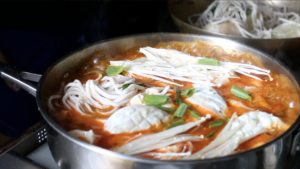
Video
Nutrition
Comments & Questions
June 7, 2021
Join The Discussion
June 7, 2021
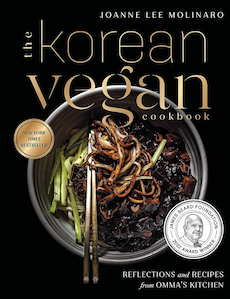
Hi,
I’m thinking of trying out this recipe (which looks really phenomenal by the way), but I was wondering if leftovers can be kept in the fridge for a few days at all? I generally cook for one.
Thank you very much!
[…] Kimchi Soondooboo Jeongol from The Korean Vegan […]
Made this yesterday and it was soo delicious the flavor is just amazing! I’m lucky enough to have a Korean grocery store less then a mile away so finding all the ingredients was fairly easy. I grabbed firm tofu at the store on accident but it was still really good. I cant wait to make it again but with silken tofu instead. It was pretty spicy lol so maybe next time I’ll do as she said and use less gochugaru. Thank you for such taste recipes!
That makes me so so happy!!! Soondooboo is a fairly challenging flavor so to hear you thought it was delicious truly makes my kimchi hearet so pleased!! And yes, you should definitely try using the silken tofu when you get a chance and go easy on the gochugaru if you found it too spicy. 🙂
We love kimchi! We are originally from Puerto Rico but have lived in Orlando, FL for what seems like for ever now. I make my own vegan kimchi following Maangchi’s vegetarian/ vegan kimchi recipe (I do use half the gochugaru 😂), so it has become a staple in my home. Even my 6yo son loves kimchi, so when I made your Kimchi Soondooboo Jeongol recipe he was obsessed. I’m making it again today with the silken tofu, I’m so excited!! By the way I can’t wait for your cookbook to come out in October 😆!!
Beth, thank you so much!! I hope you enjoy this recipe!! ~Joanne in Chicago <3
This is my favorite dish to eat, even I go to NYC Korea town!! I’m vegetarian and so so excited to try!! Thank you guys sharing your love for Korean food/real vegetarian friendly foods with us!
What’s your fav veg broth? I have tried a few and don’t like them much. Thank you!
Aww that is AMAZING!! I love K-Town in NYC too–BCD tofu house is AWESOME! As to my favorite vegetable broth, you’ll find a recipe in my cookbook (which is out this fall), but otherwise, I really like Imagine vegetable broth. 🙂